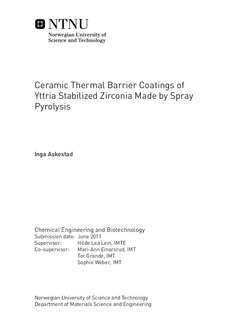Ceramic Thermal Barrier Coatings of Yttria Stabilized Zirconia Made by Spray Pyrolysis
Master thesis
Permanent lenke
http://hdl.handle.net/11250/248951Utgivelsesdato
2011Metadata
Vis full innførselSamlinger
Sammendrag
A thermal barrier coating (TBC) is used as thermal protection of metallic components exposed to hot gas streams in e.g. gas turbine engines. Due to a high thermal expansion coefficient, low thermal conductivity, chemical- and thermal stability, yttria stabilized zirconia (YSZ) is the most widely used material for TBCs today. In the work presented in this master thesis an aqueous nitrate precursor solution was prepared and deposited on stainless steel substrates by spray pyrolysis to produce 8YSZ coatings (8 mol% of Y2O3 in ZrO2). The precursor solution concentration and deposition parameters, including set-point temperature and volume sprayed, were optimized to produce continuous and crack-free green coatings.The deposited green coatings were characterized by scanning electron microscopy, thermogravimetry and Fourier transform infrared spectroscopy to study the influence of substrate temperature on the microstructure of the green coatings. A substantial change in microstructure was observed for the green coatings in a certain temperature range indicating that a minimum deposition temperature was necessary to obtain crack-free green coatings.Heat treatment was necessary to decompose the nitrate species in the deposited film. During heat treatment, vertical cracks were introduced into the coatings due to the nitrate decomposition. The cracking behavior of the coatings was studied for different drying times and conditions, and it was found that the crack propagation can be controlled to obtain the preferred size and geometry of the cracks. Due to built-up stresses in the coating, which can exceed the fracture toughness of the material, it was found that there was a maximum film thickness achievable before spallation of the coating for a given precursor solution. Therefore, the possibility of spraying multi-layered coatings was investigated. The introduction of a second layer showed that it was possible to double the thickness of the coating.
